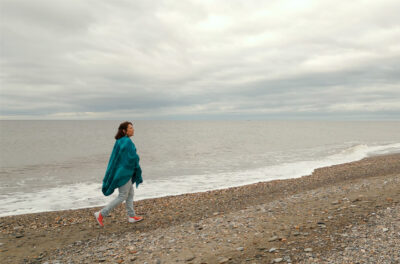Documentary about Indigenous migration includes southern Alberta site
By Theodora MacLeod - Lethbridge Herald Local Journalism Initiative Reporter on October 6, 2023.
 Submitted photo -
Alberta-born documentary maker Barbara Todd Hager, seen here walking along the shore of the Bering Sea, is currently filming a piece titled 'Leaving Beringia' which explores theories of Indigenous migration to North America.
Submitted photo -
Alberta-born documentary maker Barbara Todd Hager, seen here walking along the shore of the Bering Sea, is currently filming a piece titled 'Leaving Beringia' which explores theories of Indigenous migration to North America.What started as a saliva sample and curiosity has evolved into an expedition spanning two continents, four countries, and eight locations.
Alberta-born documentary maker Barbara Todd Hager is currently filming a piece titled ‘Leaving Beringia’ which explores theories of Indigenous migration to North America from both archaeological or scientific perspectives, and that of cultural oral history.
Curious about her genetic origins, Hager took a mail-in DNA test, and says although she has aways known she is Cree and Metis, the results of the test expanded on that much further.
“I have Mongolian DNA, I have Siberian, I have DNA from Asia, but I also have DNA from Canada, Mexico, and South America,” Hager says. “So, it started me thinking maybe we are all from the same people, maybe we are related.”
The term Beringia refers to a passageway, also known as the Bering land bridge, which sits near the west coast of Alaska and is said to have allowed for the migration of people who are now referred to as Indigenous into what is now known as North America around 12,000 to 14,000 years ago. Though it is now under the ocean, before the melting of the glaciers it is said to have connected the land masses of North America and Eastern Russia.
“The reason I called it Leaving Beringia is as a kid growing up in Alberta, I was taught in my history… social studies class that native people – back then we were called Indians, now we’re Indigenous people – got to Canada and North America by walking across this land bridge,” adding that the name has a few meanings.
“Leaving Beringia as if we had walked here; this was the theory, and also leaving Beringia behind, looking at other ways.”
In her travels, Hager is speaking with leading archeologists and Indigenous knowledge keepers to hear both oral histories and scientific theories of natural history and migration.
“My idea was to go to about my journey to these places where our ancestors are known to be, so the oldest archeological sites, and talk to the Indigenous people from those places about where they came from or how they originated. Then talk to the archeologists who excavated these sites. So, I’m looking at the two sides to the same story.”
Of the eight locations to be featured in her documentary is Wally’s Beach, which was the site of filming on Tuesday. Located at St. Mary Reservoir, northeast of Cardston, Wally’s Beach has been an important location for archeological study since the discovery of tools used by Paleoindian hunters. The area is believed to have been inhabited 11,000 years ago.
While there, Hager spoke with one of the first researchers at the site, Brian Kooyman, and Blackfoot knowledge keeper Martin Heavy Head. Hager says she saw “two perspectives talking about the same history, and it was unbelievable how much overlapped; the two stories, one science, one Indigenous.” She says that alone is proof of the strength of oral histories.
Hager and her team have already visited the location of what was once the Bering land bridge in Alaska and filmed in three Alberta locations (Wally’s Beach, Drumheller, and Edmonton). In the coming months they plan to head south with plans to film in Oregon, New Mexico, California, Mexico and Chile.
‘Leaving Beringia’ is part of the Telus Independent program and expected to be released in 2024 on Telus TV+ and OptikTV.
14-13



Christians believe that we all come from Adam and Eve, and because of the great flood from Noah. The lands were all one at one point before God separated it into continents as we know it. We were all newcomers to this land at one point!
We all bleed the same and are all one people! Sad we cannot unite as one, but fracture into groups attacking one another, for the most part.